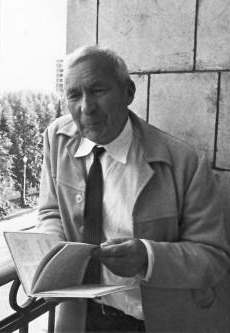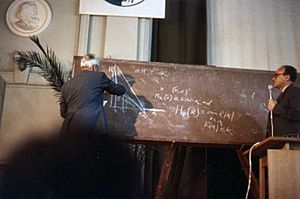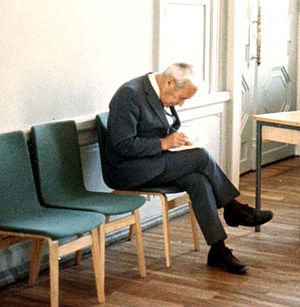Andrey Kolmogorov facts for kids
Quick facts for kids
Andrey Kolmogorov
|
|
|---|---|
 |
|
| Born |
Andrey Nikolaevich Kolmogorov
25 April 1903 Tambov, Russian Empire
|
| Died | 20 October 1987 (aged 84) |
| Citizenship | Soviet Union |
| Alma mater | Moscow State University (Ph.D.) |
| Known for |
|
| Spouse(s) |
Anna Dmitrievna Egorova
(m. 1942–1987) |
| Awards |
|
| Scientific career | |
| Fields | Mathematics |
| Institutions | Moscow State University |
| Doctoral advisor | Nikolai Luzin |
| Doctoral students |
|
Andrey Nikolaevich Kolmogorov (Russian: Андре́й Никола́евич Колмого́ров, 25 April 1903 – 20 October 1987) was a famous Soviet mathematician. He made huge contributions to many areas of mathematics. These included probability theory, topology, and classical mechanics. He also worked on turbulence and algorithmic information theory.
Biography
Early life and discoveries
Andrey Kolmogorov was born in Tambov, Russia, in 1903. His mother passed away when he was born. He was raised by his aunts near Yaroslavl. His grandfather was a well-known nobleman.
Andrey's father, Nikolai Matveyevich Katayev, was an agronomist. He disappeared in 1919 during the Russian Civil War.
Andrey went to his aunt Vera's village school. Even at a young age, he showed great talent. His first writings and math papers were in the school journal, "The Swallow of Spring". At just five years old, he was the "editor" of the math section. He even published his first math discovery there. He noticed a pattern in adding odd numbers: 1 = 1², 1 + 3 = 2², and so on.
In 1910, his aunt adopted him, and they moved to Moscow. He finished high school in 1920. That same year, he started studying at Moscow State University. He also attended the Mendeleev Moscow Institute of Chemistry and Technology. He already knew a lot about math, including set theory.
Kolmogorov was known for his wide knowledge. As a college student, he studied history and published a paper on land ownership in the Novgorod Republic. At the same time, he worked on set theory and Fourier series.
Becoming a mathematician
In 1922, Kolmogorov became famous for his work on Fourier series. This is when he decided to dedicate his life to mathematics.
In 1925, he graduated from Moscow State University. He began working with his supervisor, Nikolai Luzin. He also became close friends with Pavel Alexandrov, another student. Kolmogorov became very interested in probability theory with Aleksandr Khinchin. In 1925, he published work on intuitionistic logic. He earned his Doctor of Philosophy (Ph.D.) degree in 1929.
In 1930, Kolmogorov traveled to Germany and France. He met many scientists and published his important work on probability theory in 1931. That same year, he became a professor at Moscow State University.
In 1933, Kolmogorov published his book, Foundations of the Theory of Probability. This book created the modern rules for probability theory. It made him a world leader in the field. In 1935, he became the first head of the probability theory department at Moscow State University. Around 1936, he also worked on ecology. He improved the Lotka–Volterra equations for how predators and prey interact.
During World War II, Kolmogorov helped the Soviet war effort. He used statistics to improve artillery fire. He also designed a way to use barrage balloons to protect Moscow from German bombers.
Kolmogorov and British mathematician Sydney Chapman created important equations for stochastic processes. These are called the Chapman–Kolmogorov equations.
Later, Kolmogorov focused on turbulence, which is about how fluids move in a chaotic way. His work from 1941 was very important in this area. In classical mechanics, he is known for the Kolmogorov–Arnold–Moser theorem. He first presented it in 1954. In 1957, with his student Vladimir Arnold, he solved a part of Hilbert's thirteenth problem. Around this time, he also helped create algorithmic complexity theory. This is often called Kolmogorov complexity theory.
Kolmogorov married Anna Dmitrievna Egorova in 1942. He loved teaching throughout his life. He taught at the university and also worked with younger children. He helped create ways to teach gifted children in literature, music, and math. At Moscow State University, he led several departments. These included probability, statistics, and random processes. He also led the mathematical logic department. He was even the Dean of the Moscow State University Department of Mechanics and Mathematics.
In 1971, Kolmogorov joined an oceanographic trip on the research ship Dmitri Mendeleev. He wrote many articles for the Great Soviet Encyclopedia. In his later years, he thought a lot about how probability theory connects to both abstract ideas and real-world uses.
Kolmogorov passed away in Moscow in 1987. He is buried in the Novodevichy cemetery.
A famous quote from Kolmogorov is: "Every mathematician believes that he is ahead of the others. The reason none state this belief in public is because they are intelligent people."
The famous mathematician Vladimir Arnold once said that only five lives separate us from the start of our science: "Kolmogorov – Poincaré – Gauss – Euler – Newton." This shows how important Kolmogorov was.
Awards and honours
Kolmogorov received many awards and honours during his life and after:
- Member of the Russian Academy of Sciences
- Awarded the Stalin Prize in 1941
- Elected an Honorary Member of the American Academy of Arts and Sciences in 1959
- Elected member of the American Philosophical Society in 1961
- Awarded the Balzan Prize in 1962
- Elected a Foreign Member of the Royal Netherlands Academy of Arts and Sciences in 1963
- Elected a Foreign Member of the Royal Society (ForMemRS) in 1964.
- Awarded the Lenin Prize in 1965
- Elected member of the United States National Academy of Sciences in 1967
- Awarded the Wolf Prize in 1980
- Awarded the Lobachevsky Prize in 1986
Many things are named after Kolmogorov to honour him:
- Fisher–Kolmogorov equation
- Johnson–Mehl–Avrami–Kolmogorov equation
- Kolmogorov axioms
- Kolmogorov equations
- Kolmogorov dimension
- Kolmogorov–Arnold theorem
- Kolmogorov–Arnold–Moser theorem
- Kolmogorov continuity theorem
- Kolmogorov's criterion
- Kolmogorov extension theorem
- Kolmogorov's three-series theorem
- Convergence of Fourier series
- Gnedenko-Kolmogorov central limit theorem
- Quasi-arithmetic mean (Kolmogorov mean)
- Kolmogorov homology
- Kolmogorov's inequality
- Landau–Kolmogorov inequality
- Kolmogorov integral
- Brouwer–Heyting–Kolmogorov interpretation
- Kolmogorov microscales
- Kolmogorov's normability criterion
- Fréchet–Kolmogorov theorem
- Kolmogorov space
- Kolmogorov complexity
- Kolmogorov–Smirnov test
- Wiener filter (Wiener–Kolmogorov filtering theory)
- Wiener–Kolmogorov prediction
- Kolmogorov automorphism
- Kolmogorov's characterization of reversible diffusions
- Borel–Kolmogorov paradox
- Chapman–Kolmogorov equation
- Hahn–Kolmogorov theorem
- Johnson–Mehl–Avrami–Kolmogorov equation
- Kolmogorov–Sinai entropy
- Astronomical seeing described by Kolmogorov's turbulence law
- Kolmogorov structure function
- Kolmogorov–Uspenskii machine model
- Kolmogorov's zero–one law
- Kolmogorov–Zurbenko filter
- Kolmogorov's two-series theorem
- Rao–Blackwell–Kolmogorov theorem
- Khinchin–Kolmogorov theorem
- Kolmogorov's Strong Law of Large Numbers
See also
 In Spanish: Andréi Kolmogórov para niños
In Spanish: Andréi Kolmogórov para niños



